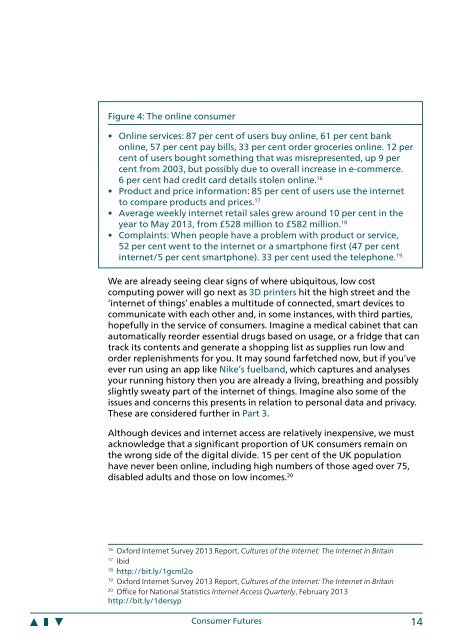Realising-consumer-rights
Realising-consumer-rights
Realising-consumer-rights
You also want an ePaper? Increase the reach of your titles
YUMPU automatically turns print PDFs into web optimized ePapers that Google loves.
Figure 4: The online <strong>consumer</strong><br />
• Online services: 87 per cent of users buy online, 61 per cent bank<br />
online, 57 per cent pay bills, 33 per cent order groceries online. 12 per<br />
cent of users bought something that was misrepresented, up 9 per<br />
cent from 2003, but possibly due to overall increase in e-commerce.<br />
6 per cent had credit card details stolen online. 16<br />
• Product and price information: 85 per cent of users use the internet<br />
to compare products and prices. 17<br />
• Average weekly internet retail sales grew around 10 per cent in the<br />
year to May 2013, from £528 million to £582 million. 18<br />
• Complaints: When people have a problem with product or service,<br />
52 per cent went to the internet or a smartphone first (47 per cent<br />
internet/5 per cent smartphone). 33 per cent used the telephone. 19<br />
We are already seeing clear signs of where ubiquitous, low cost<br />
computing power will go next as 3D printers hit the high street and the<br />
‘internet of things’ enables a multitude of connected, smart devices to<br />
communicate with each other and, in some instances, with third parties,<br />
hopefully in the service of <strong>consumer</strong>s. Imagine a medical cabinet that can<br />
automatically reorder essential drugs based on usage, or a fridge that can<br />
track its contents and generate a shopping list as supplies run low and<br />
order replenishments for you. It may sound farfetched now, but if you’ve<br />
ever run using an app like Nike’s fuelband, which captures and analyses<br />
your running history then you are already a living, breathing and possibly<br />
slightly sweaty part of the internet of things. Imagine also some of the<br />
issues and concerns this presents in relation to personal data and privacy.<br />
These are considered further in Part 3.<br />
Although devices and internet access are relatively inexpensive, we must<br />
acknowledge that a significant proportion of UK <strong>consumer</strong>s remain on<br />
the wrong side of the digital divide. 15 per cent of the UK population<br />
have never been online, including high numbers of those aged over 75,<br />
disabled adults and those on low incomes. 20<br />
16<br />
Oxford Internet Survey 2013 Report, Cultures of the Internet: The Internet in Britain<br />
17<br />
Ibid<br />
18<br />
http://bit.ly/1gcml2o<br />
19<br />
Oxford Internet Survey 2013 Report, Cultures of the Internet: The Internet in Britain<br />
20<br />
Office for National Statistics Internet Access Quarterly, February 2013<br />
http://bit.ly/1dersyp<br />
Consumer Futures 14


